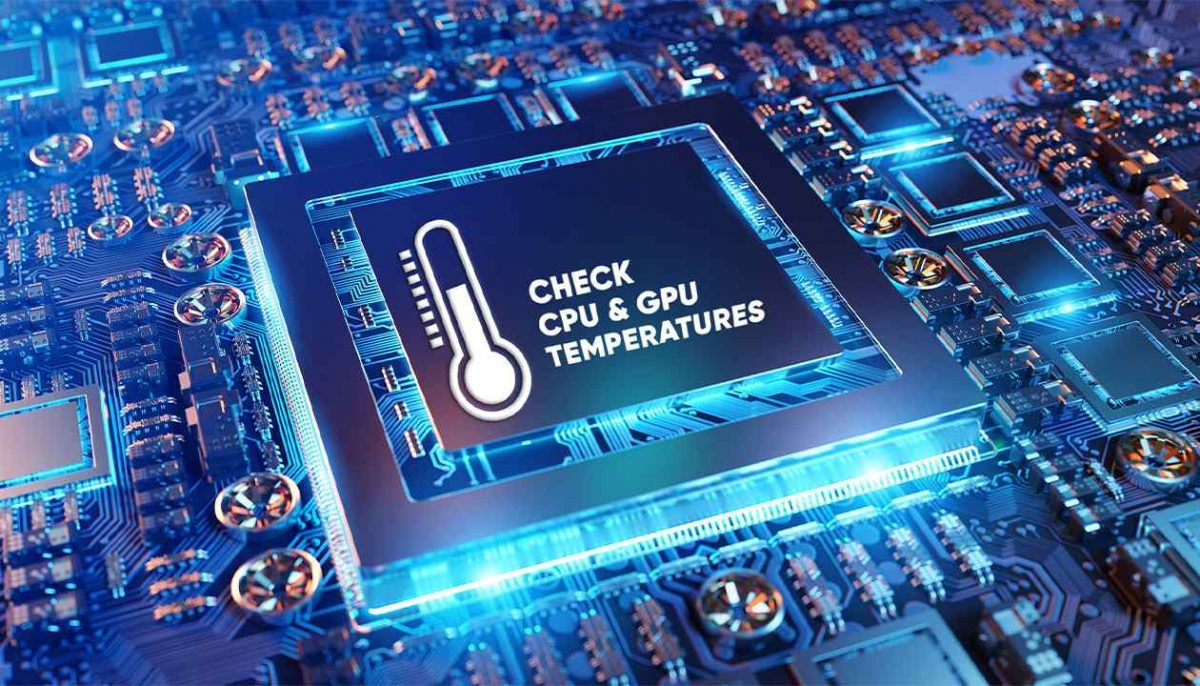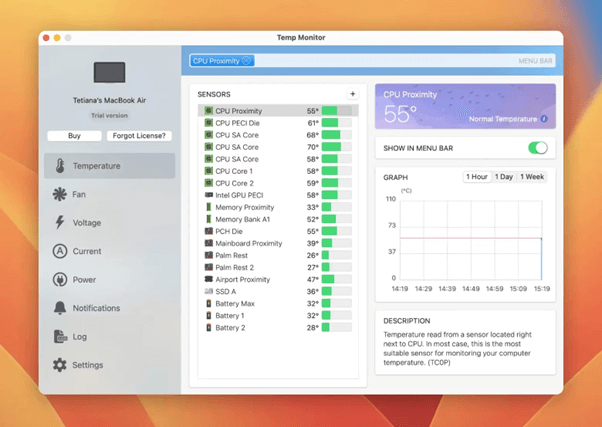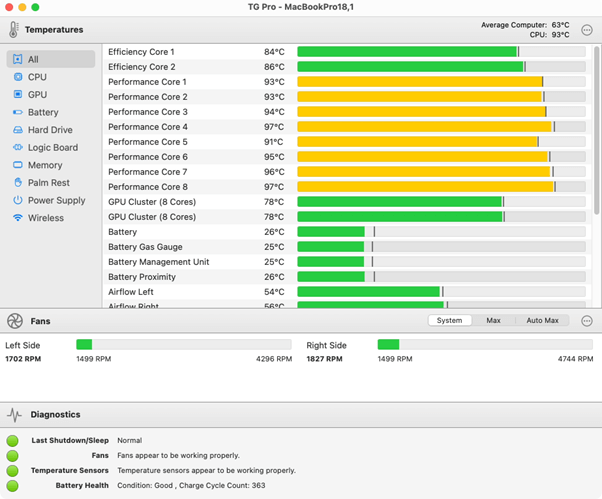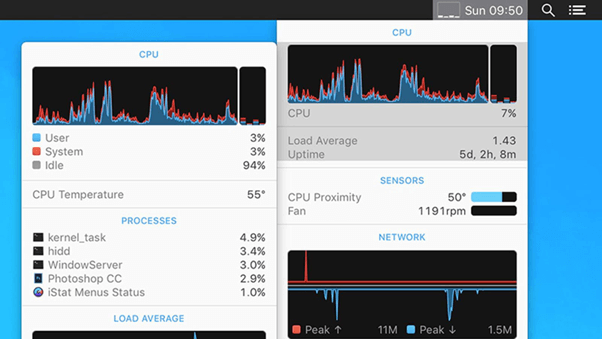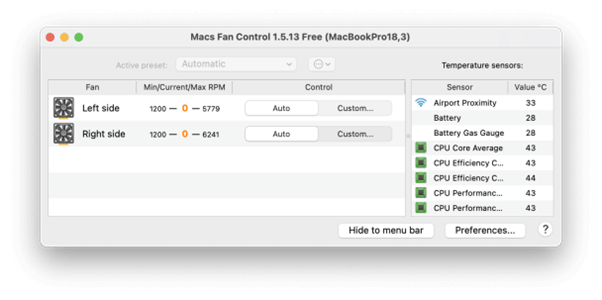How to Check Your Mac’s CPU and GPU Temperatures | Prevent Overheating Your Mac
Knowing your Mac’s CPU and GPU temperatures is important to monitor your system’s health and performance. Excessively high temperatures can cause system crashes, slow performance, and hardware damage over time. Moreover, regularly checking your Mac’s temperatures can help you identify cooling issues or system resource hogs before they become problematic.
In this guide, we have listed several methods to check both CPU and GPU temperatures on any Mac running macOS 10.9 Mavericks or newer versions.
We’ll look at built-in macOS tools as well as third-party Mac temperature monitor utilities to keep a check on the current and historical temperature data. Whether you have an Intel or Apple silicon Mac, you’ll find a solution here to start monitoring your Mac’s vital signs.
Also read: 10 Best Mac Temperature Monitor Apps
How to Check CPU Temperature with Activity Monitor
All Macs come with the Activity Monitor built into macOS, providing a quick way to get current CPU temperature readings. To check CPU temp Mac, follow these steps:
- Open Activity Monitor – You can find it using Spotlight or in /Applications/Utilities.
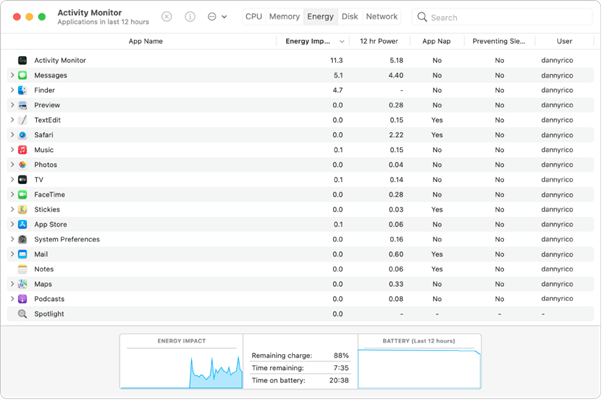
- Navigate to the CPU tab.
- Check the Temperature column on the right. This shows the current CPU temperature in degrees Celsius or Fahrenheit.
The CPU temperature will fluctuate frequently, especially on laptops, so expect variation. Look for sustained high temperatures over 90°C / 194°F under load or spikes over 100°C / 212°F, which may indicate cooling issues.
Activity Monitor is handy for a quick current reading but doesn’t log history. For that, we need to turn to third-party tools.
Also read: Kernel_task: What It Is, Why It Causes High CPU Usage & How to Fix It On Mac
Use Temp Monitor Mac for Detailed Readings
Temp Monitor Mac is a free and lightweight utility focused specifically on monitoring Mac temperatures. It provides detailed current and historic readings of all temperature sensors.
To use Temp Monitor Mac:
- Download and open Temp Monitor Mac.
- The app will begin scanning and display all available temperature readings on the left.
- You can view current temps as well as 7-day, 30-day, or 365-day histories for each sensor.
- Click on any sensor to enlarge its temperature graph and get current, average, minimum, and maximum values.
- Customize which sensors are displayed in the menu bar widget.
Temp Monitor Mac provides an easy way to view temperature data beyond just the CPU and GPU. With detailed historical graphs and customizable alerts, you can closely track sensors showing abnormal spikes or sustained high readings indicative of cooling issues.
Use TG Pro to Monitor CPU and GPU Temps
TG Pro is an efficient utility for monitoring Mac temperatures. The free version of this temp monitor Mac app displays current CPU and GPU temps, while the paid Pro version provides additional features, such as
- Graphical representation of Temperature over time.
- Full fan speed control.
- Temperature alerts/notifications.
- Customizable menu bar icon.
- More robust GPU temperature monitoring.
To view current CPU and GPU temperature readings with TG Pro:
- Download, install, and open TG Pro.
- The main window will display current CPU and GPU temperatures toward the top. They update in real-time.
- For GPU temperature, click the arrow next to the GPU entry to see the reading for each separate GPU if you have more than one.
TG Pro makes it easy to monitor fluctuations over time. For advanced features, grab the Pro version for under $20. But the free version works great for occasional temperature checks.
Also read: TG Pro Review: Temperature Monitoring Tool For Mac
Use iStat Menus to Display Temperatures in Menu Bar
iStat Menus is another popular Mac temperature utility, that presents CPU and GPU stats right in your menu bar. The app is free to try with full functionality for one week. After that, you need to upgrade to the full version:
To use iStat Menus to check CPU temp Mac, follow these steps:
- Download, install, and open iStat Menus.
- In the menu bar, click the iStat Menus icon and select Temperature Sensor.
- This adds the Temperature Sensor menu which reports CPU and GPU temps. Hover over each entry to see min/max values too.
- Open Preferences to customize which readings you see, temperature units, and appearance.
For $20, iStat Menus provides all kinds of hardware monitors beyond just temperature, including advanced GPU readings. But the free trial works great for occasional temperature checks.
Use Macs Fan Control for CPU and GPU Temperature History
Macs Fan Control lets you monitor real-time Mac temperatures as well as view historical temperature data. The app is donationware, offering full functionality for free.
To use the Macs Fan Control app for temp monitoring, all you have to do is:
- Download and open Macs Fan Control.
- Click the Temperature tab. Current CPU and GPU temperature readings will be displayed toward the top.
- Open any of the log files along the left sidebar to view the recorded temperature history in intricate detail for each of your Mac’s sensors.
The Temperature History visualizer also lets you view this data in graphical format. You can monitor trends over time to spot abnormal spikes. Check out Mac Fan Control if you want robust historical temperature data beyond what Activity Monitor provides.
Also read: How to Delete Apps from Launchpad that Won’t Delete
BONUS Tips to Optimize Your Mac’s Cooling
Now that you know how to monitor your Mac’s current and historical temperatures, you can take further steps to lower concerning readings:
- Clean the fans and vents using compressed air to improve airflow.
- Lower resource usage by closing apps and browser tabs.
- Adjust power settings to favor cooler operation over peak performance.
- Use a laptop cooling pad, which can dramatically lower temperatures under load.
- If problems persist, consider reapplying high-quality thermal paste between the CPU/GPU and cooler.
With proper monitoring and cooling maintenance, your Mac should operate at safe, optimal temperatures for years to come.
Don’t Let Your Mac Burn Up: Keep an Eye on Your CPU and GPU Temperatures
Checking and optimizing your Mac’s CPU and GPU temperatures is a crucial task to maintain the performance and longevity of your MacBook. With the built-in tools in macOS and utilities like TG Pro, iStat Menus, and Mac Fan Control, you can easily keep an eye on critical temperature data and take necessary steps to prevent overheating and other issues.
Monitoring for spikes and high sustained readings allows you to proactively manage cooling before serious issues arise. Keep your Mac running cool and smoothly for years to come with proper temperature hygiene.
FAQs –
Q1: How Can I Monitor My Mac’s Temperature?
A: You can monitor your Mac’s temperature using third-party applications that specialize in tracking temperature metrics. These apps provide real-time data on various hardware components, including CPU and GPU temperatures, allowing you to keep an eye on your system’s thermal performance.
Q2: What Are the Recommended CPU Temperature Monitoring Apps for Mac?
There are several reliable third-party applications for monitoring CPU temperatures on Mac. Some popular choices include iStat Menus, Mac Fan Control, and Intel Power Gadget. These apps offer comprehensive insights into temperature fluctuations and system performance.
Q3: How to Ensure Accurate Computer Temperature Monitoring on a Mac?
To ensure accurate temperature monitoring on a Mac, it’s essential to use reputable and updated monitoring applications from trusted sources. Additionally, keep these apps regularly updated to access the latest features and improvements for accurate temperature readings.
Q4: Can Monitoring CPU and GPU Temperatures Improve Mac Performance?
Monitoring CPU and GPU temperatures doesn’t directly improve performance. However, it helps in maintaining optimal conditions by preventing overheating, which can lead to thermal throttling and performance degradation. By keeping an eye on temperatures, users can manage cooling systems more effectively, potentially enhancing overall system performance.

